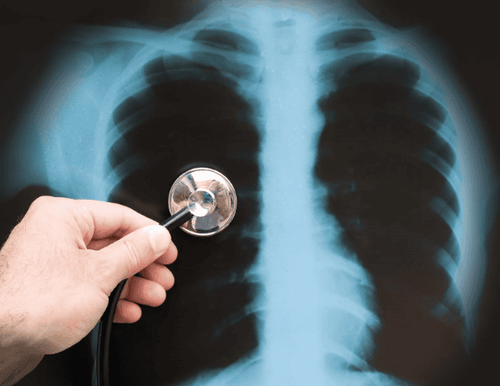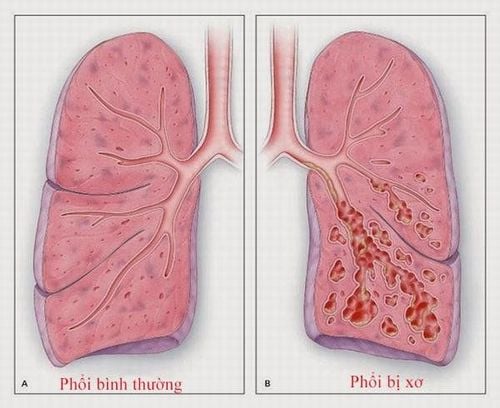This is an automatically translated article.
The article is professionally consulted by Master, Doctor Nguyen Van Anh - Radiologist - Department of Diagnostic Imaging and Nuclear Medicine - Vinmec Times City International Hospital
1. What is interstitial pulmonary fibrosis?
Interstitial pulmonary fibrosis is a group of disorders characterized by progressive scarring of the lung tissue that lies between and supporting the air sacs. The scarring associated with pulmonary fibrosis can cause a person's lungs to stiffen, gradually affecting their ability to breathe and absorb oxygen into the bloodstream.
The cause of interstitial pulmonary fibrosis may be lung trauma, which in turn leads to the activation of an abnormal rebound response. Specifically, the faulty healing process causes the tissue around the air sacs to scar and thicken, making it more difficult for oxygen to get into the bloodstream.
Besides, some other causes such as autoimmune diseases, exposure to too much organic and inorganic agents, use of drugs that damage the lungs and some types of radiation during cancer treatment . In some cases, the cause of the disease is unknown, so it is called idiopathic interstitial pulmonary fibrosis.

2. What medical technique is used to diagnose interstitial lung disease?
Most symptoms of interstitial lung disease are nonspecific. However, a careful history of exposure to risk factors as well as the medical history and clinical symptoms will help confirm the diagnosis of interstitial lung fibrosis. Some clinical symptoms of the disease such as:
Shortness of breath: The patient often begins to have difficulty breathing with exertion and then gradually increases. However, there are rare cases of acute onset dyspnea; Cough: When having interstitial pulmonary fibrosis, the patient may have a cough, mainly dry cough or hemoptysis; Other rare symptoms such as chest pain or wheezing; In addition, patients may experience musculoskeletal pain, fatigue, fever, edema, light-sensitive skin, dry eyes, and dry mouth. These are extrapulmonary symptoms; Signs in the lungs may be symptoms of disease such as auscultation of the lungs with crackles, small moist particles at the bottom of the lungs on both sides. However, depending on the clinical situation, the doctor will order a number of other medical tests to diagnose interstitial lung fibrosis most accurately. These tests include:
Chest X-ray: This test is usually ordered first to evaluate for breathing problems. If you have interstitial fibrosis, the chest X-ray will show wrinkles in the lungs;

CT scan of the lungs: This method will create detailed images of the surrounding structures and lungs. Therefore, CT scan often detects interstitial lung disease; High-resolution CT scan: This method aims to increase the scanning capacity of CT scan and detect interstitial pulmonary fibrosis; Pulmonary function test: This tests the total lung capacity and ability to carry oxygen into the bloodstream by having a person sit in a sealed plastic chamber and breathe through a tube. If the total lung capacity and ability to carry oxygen into the blood are reduced, the person is likely to have interstitial fibrosis; Lung biopsy: The method of collecting lung tissue for examination under a microscope is the only way to identify interstitial lung fibrosis. Some ways to collect lung tissue include bronchoscopy to sample lung tissue, video-assisted chest surgery, or open lung biopsy for lung biopsy.
3. What methods are used to treat interstitial lung disease?
Treatment for interstitial lung fibrosis is determined according to the cause of the disease. Treatments include:
Medication: Your doctor will use medicine to slow down scarring. If the patient has additional signs of a disease such as cardiovascular, osteoarthritis, then it may be necessary to discuss with specialists to optimize the care process.

Oxygen therapy: This will not prevent lung damage, but may help the person breathe easier; It can also prevent or reduce complications of low blood oxygen levels, lower blood pressure on the right side of the heart, and aid in sleep. Surgery: If the above treatments do not work, lung transplant surgery is the last option for people with severe interstitial fibrosis. In addition, to limit the progression of interstitial lung fibrosis, patients need to quit smoking, have a nutritious diet containing adequate calories, and maintain exercise and sports to avoid this condition. Weakened body condition due to chronic diseases and most importantly, vaccination against respiratory infections such as pneumonia vaccine, flu vaccine.
As soon as there are signs of interstitial lung fibrosis, the patient needs to go to a reputable hospital for immediate examination and treatment. Currently, Vinmec International General Hospital is one of the leading prestigious hospitals in the country, trusted by a large number of patients for medical examination and treatment. Not only the physical system, modern equipment: 6 ultrasound rooms, 4 DR X-ray rooms (1 full-axis machine, 1 light machine, 1 general machine and 1 mammography machine) , 2 DR portable X-ray machines, 2 multi-row CT scanner rooms (1 128 rows and 1 16 arrays), 2 Magnetic resonance imaging rooms (1 3 Tesla and 1 1.5 Tesla), 1 room for 2 levels of interventional angiography and 1 room to measure bone mineral density.... Vinmec is also the place to gather a team of experienced doctors and nurses who will greatly assist in diagnosis and detection. early signs of abnormality in the patient's body. In particular, with a space designed according to 5-star hotel standards, Vinmec ensures to bring the patient the most comfort, friendliness and peace of mind.
Please dial HOTLINE for more information or register for an appointment HERE. Download MyVinmec app to make appointments faster and to manage your bookings easily.














